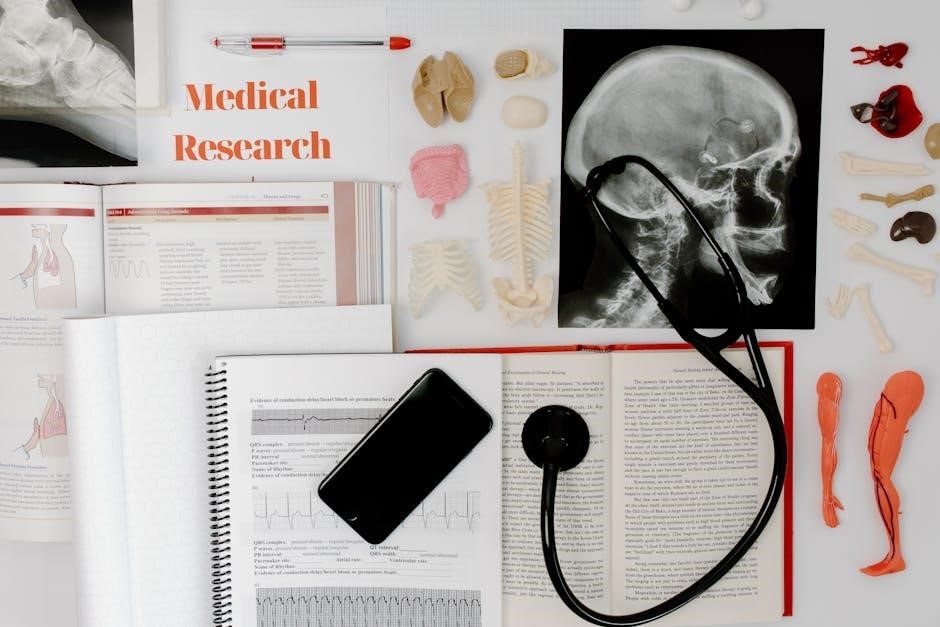“Anatomy of the Spirit” by Caroline Myss is a seminal work exploring the intersection of spirituality and physical health. It introduces the concept of energy medicine, detailing how spiritual imbalances manifest as physical illnesses. Myss, a renowned medical intuitive, presents a groundbreaking model of the human energy system, emphasizing the seven chakras and their role in personal power and healing. This book is a must-read for those seeking to understand the profound connection between body, mind, and spirit.
1.1 Overview of the Book and Its Author
“Anatomy of the Spirit” is a groundbreaking book by Caroline Myss, a renowned medical intuitive and pioneer in the field of energy medicine. First published in 1996, the book explores the connection between spirituality and physical health, offering a comprehensive guide to understanding the human energy system. Myss introduces the concept of the seven chakras and their role in personal power, healing, and spiritual growth. Her work bridges the gap between traditional medicine and spiritual practices, making it a foundational text for those interested in holistic health and consciousness.
1.2 The Concept of Energy Medicine
Energy medicine, as explored in “Anatomy of the Spirit,” is a holistic approach to health that views the body as a dynamic energy system. Caroline Myss explains that this system, composed of seven chakras, influences both physical and spiritual well-being. She posits that imbalances in this energy system can lead to illness, while alignment and harmony promote healing. Myss’s approach integrates intuition, spirituality, and traditional medicine, offering a unique perspective on how energy flows through the body and impacts overall health. This concept forms the foundation of her teachings on power and healing.
1.3 The Seven Stages of Power and Healing
The Seven Stages of Power and Healing, as outlined in “Anatomy of the Spirit,” represent a transformative journey from personal empowerment to spiritual mastery. Caroline Myss describes these stages as a progression of self-awareness, where individuals confront and release emotional and spiritual wounds. Each stage builds upon the previous one, guiding the individual toward alignment with their true purpose and divine plan. The ultimate goal is to achieve spiritual mastery, where one embodies grace, lives in the present, and surrenders to a higher power. This framework offers a profound path to healing and self-realization.
The Seven Chakras and Their Significance
The seven chakras are a cornerstone of Caroline Myss’s teachings in “Anatomy of the Spirit,” representing seven spiritual life lessons essential for human evolution. Each chakra symbolizes a specific aspect of consciousness and energy, guiding individuals toward higher awareness and holistic well-being. Understanding these chakras is key to unlocking personal power, healing, and spiritual growth, as they bridge the physical and spiritual dimensions of human existence.
2.1 Root Chakra: Stability and Grounding
The Root Chakra, located at the base of the spine, is the foundation of the energy system, governing stability, grounding, and a sense of safety. It connects us to the Earth and our basic needs, ensuring physical and emotional well-being. Imbalances in this chakra can manifest as anxiety, insecurity, or a lack of vitality. By addressing issues related to survival, belonging, and grounding, one can restore balance to the Root Chakra, fostering a sense of security and stability essential for overall health and spiritual growth.
2.2 Sacral Chakra: Creativity and Emotions
The Sacral Chakra, located in the lower abdomen, governs creativity, emotions, and sexuality. It represents the flow of life force energy and the ability to experience pleasure and joy. Blockages here can lead to emotional turmoil, creative stagnation, or sexual dysfunction. This chakra teaches the lesson of learning to let go and trust in the flow of life. By addressing emotional wounds and fostering creativity, one can restore balance to the Sacral Chakra, enhancing emotional well-being and fostering a deeper connection to one’s passions and desires.
2.3 Solar Plexus Chakra: Personal Power and Self-Esteem
The Solar Plexus Chakra, located in the upper abdomen, is the seat of personal power, self-esteem, and willpower. It governs self-confidence, intuition, and the ability to set healthy boundaries. When balanced, this chakra fosters a strong sense of identity and self-worth. Imbalances can manifest as low self-esteem, fear of rejection, or controlling behaviors. Healing this chakra involves reclaiming personal power, embracing authenticity, and releasing past traumas that diminish self-confidence. By nurturing self-respect and intuition, one can restore harmony to the Solar Plexus Chakra, empowering a more confident and self-assured life.
2.4 Heart Chakra: Love and Compassion
The Heart Chakra, located at the center of the chest, governs emotions, love, and compassion. It bridges the lower and upper chakras, connecting earthly and spiritual energies. This chakra teaches the lessons of love, self-love, and the ability to form meaningful relationships. Imbalances may manifest as emotional pain, loneliness, or an inability to connect deeply with others. Healing the Heart Chakra involves releasing emotional wounds, fostering empathy, and nurturing self-love. A balanced Heart Chakra allows for profound connections, unconditional love, and harmony between the physical and spiritual selves, aligning one with their true capacity for compassion and joy.
2.5 Throat Chakra: Communication and Authenticity

The Throat Chakra, located in the neck, governs communication, self-expression, and authenticity. It is the bridge between the heart and mind, enabling truthful expression of one’s thoughts and emotions. This chakra teaches the importance of speaking one’s truth and listening with empathy. Blockages here may result in difficulty articulating feelings, fear of judgment, or dishonest communication. Healing involves embracing vulnerability, practicing active listening, and aligning words with personal values. A balanced Throat Chakra fosters clear, heartfelt communication, empowering individuals to express their authentic selves and connect deeply with others.
2.6 Third Eye Chakra: Intuition and Insight
The Third Eye Chakra, located between the eyebrows, is the seat of intuition, insight, and psychic abilities. It governs perception, wisdom, and the ability to see beyond the physical realm. Associated with the color indigo, this chakra connects us to higher states of consciousness and divine guidance. Blockages may manifest as distrust in intuition, mental fogginess, or an overreliance on logic. Healing involves practices like meditation, visualization, and trusting inner wisdom. A balanced Third Eye Chakra enhances clarity, discernment, and the ability to navigate life with spiritual awareness and inner guidance.
2.7 Crown Chakra: Spiritual Connection and Enlightenment
The Crown Chakra, located at the top of the head, represents spiritual connection and enlightenment. It is associated with the color violet and governs higher consciousness, divine wisdom, and unity with the universe. This chakra is the gateway to spiritual awakening, enabling us to transcend the physical and embrace the infinite. Blockages may manifest as feelings of disconnection or existential fear. Healing involves meditation, prayer, and surrendering to the divine. A balanced Crown Chakra fosters spiritual mastery, self-realization, and a profound sense of oneness with all existence, fulfilling the ultimate purpose of human consciousness.
The Intersection of Anatomy and Spirituality
“Anatomy of the Spirit” explores how physical and spiritual aspects of human beings interrelate, revealing energy systems that influence health and consciousness. This profound connection enhances understanding of wholeness and well-being.
3.1 Understanding the Energy Body
The energy body, as described in “Anatomy of the Spirit”, is a vital system comprising chakras, auras, and meridians that interact with the physical body. It governs health and consciousness, with imbalances manifesting as illness. Caroline Myss explains that understanding this system is key to holistic healing, as it bridges spirituality and physiology. The seven chakras, representing spiritual life lessons, play a central role in this framework, influencing emotional, mental, and physical well-being. This concept revolutionizes traditional medicine by emphasizing the interconnectedness of energy and physical health.
3.2 The Role of Chakras in Physical and Spiritual Health
In “Anatomy of the Spirit”, Caroline Myss explains that chakras are vital energy centers governing physical, emotional, and spiritual well-being. Each chakra corresponds to specific life lessons and organs, influencing health. Blockages in these centers can lead to illness, while balance fosters vitality. The chakras act as bridges between the spiritual and physical realms, making them essential for holistic healing. Myss emphasizes that understanding and aligning the chakras is crucial for addressing the root causes of disease and achieving spiritual growth, as they hold the key to integrating body, mind, and spirit.
3.3 How Spiritual Imbalances Manifest in the Physical Body
In “Anatomy of the Spirit”, Caroline Myss reveals that spiritual imbalances often manifest as physical illnesses. Emotional and spiritual wounds, such as unresolved grief or fear, can block energy flow, leading to bodily dysfunction. For instance, issues in the heart chakra may correlate with heart disease, while throat chakra blockages can cause throat problems. Myss teaches that these physical symptoms are not random but are deeply connected to unaddressed spiritual and emotional conflicts. By healing the spirit, individuals can restore balance to the body, emphasizing the interconnectedness of health and spirituality.

The Seven Stages of Power and Healing
“Anatomy of the Spirit” outlines a transformative framework for personal growth and healing. Caroline Myss’s seven stages guide individuals through self-discovery, empowerment, and spiritual alignment, fostering holistic well-being.
4.1 Stage 1: Understanding the Power of Choice
Stage 1 introduces the foundational concept of personal agency, emphasizing how choices shape our reality. Caroline Myss explains that every decision influences our spiritual and physical well-being, creating a ripple effect. This stage encourages self-reflection, helping individuals recognize patterns of thought and behavior that either empower or limit them. By understanding the power of choice, one can begin to break free from destructive cycles and align with their true potential. This awareness is the first step toward healing and spiritual growth, setting the stage for deeper transformation. It is both liberating and profound.
4.2 Stage 2: Releasing Emotional and Spiritual Wounds
Stage 2 focuses on identifying and releasing deep-seated emotional and spiritual wounds that block healing. Caroline Myss emphasizes that unresolved pain creates energetic barriers, manifesting as physical or mental illness. This stage involves confronting past traumas, negative beliefs, and self-destructive patterns. By acknowledging and letting go of these wounds, individuals can restore their spiritual and emotional balance. Myss highlights the importance of self-awareness and forgiveness in this process. Releasing these burdens allows for a cleaner slate, enabling true healing and spiritual growth to begin. This step is crucial for progressing through the subsequent stages of power and transformation.
4.3 Stage 3: Aligning with Personal Truth

Stage 3 involves aligning with personal truth, a critical step in the healing journey. Caroline Myss explains that this stage requires embracing authenticity and integrity, letting go of false beliefs and societal expectations. By tuning into one’s inner voice, individuals can identify and honor their true values and desires. This alignment fosters self-awareness and empowers individuals to make decisions that reflect their authentic selves. Myss emphasizes that living in accordance with personal truth is essential for healing and spiritual growth, as it restores integrity and promotes harmony between the physical and spiritual realms. This stage is about embracing who you truly are.
4.4 Stage 4: Embracing the Power of Grace
Stage 4 focuses on embracing the power of grace, a transformative force that transcends human effort. Caroline Myss describes grace as an invisible energy that heals and aligns the spirit with divine will. This stage involves surrendering resistance and trusting in a higher power, allowing grace to dissolve negative patterns and restore balance. By humbly opening to grace, individuals experience profound healing and spiritual renewal. Myss emphasizes that grace is not earned but received through faith and willingness, making it a cornerstone of the healing journey. It brings harmony to the body, mind, and spirit.
4.5 Stage 5: Surrendering to the Divine Plan
Stage 5 involves surrendering to the divine plan, a profound act of trust in a higher power. Caroline Myss explains that true healing occurs when we release attachment to personal will and align with divine intent. Surrendering is not about passivity but about embracing the flow of life, allowing spiritual forces to guide us. This stage brings liberation from ego-driven struggles, enabling us to trust in the universe’s plan. By letting go of resistance, we open ourselves to divine guidance, fostering deeper healing and alignment with our true purpose. This surrender is a powerful step toward spiritual mastery and inner peace.
4.6 Stage 6: Living in the Present Moment
Stage 6 emphasizes the importance of living in the present moment, a cornerstone of spiritual growth. Caroline Myss teaches that dwelling on the past or worrying about the future creates emotional and spiritual blockages. By focusing on the now, individuals release burdens and align with their true selves. This stage fosters mindfulness, allowing for a deeper connection to intuition and inner peace. Living in the present moment is not just a practice but a state of being that enhances healing and accelerates spiritual evolution, freeing one from the weight of time and regret. It is a powerful step toward harmony and self-realization.
4.7 Stage 7: Achieving Spiritual Mastery

Stage 7 represents the pinnacle of spiritual evolution, where one attains mastery over the ego and aligns fully with the divine will. Caroline Myss describes this stage as a state of complete liberation from fear, doubt, and attachment. It is characterized by a deep understanding of universal truths and the ability to embody them effortlessly. Spiritual mastery is not about perfection but about living in harmony with the universe, guided by intuition and wisdom. This stage signifies the culmination of the seven stages, where one transcends the physical and spiritual realms, achieving a state of oneness with all existence. It is the ultimate expression of healing and enlightenment.

Practical Applications of Energy Healing
Energy healing offers practical tools for balancing the body, mind, and spirit. Techniques like chakra alignment and intuitive practices help restore harmony and promote well-being, as detailed in “Anatomy of the Spirit.”
5.1 Techniques for Balancing the Chakras

Chakra balancing is a cornerstone of energy healing, as explored in “Anatomy of the Spirit”. Techniques include meditation, sound therapy, and yoga to align and clear energy blockages.
– Meditation focuses on visualizing light flowing through each chakra.
– Sound therapy uses specific frequencies to harmonize energy.
– Yoga employs postures and breathwork to activate chakra centers.
These practices restore balance, enhancing physical, emotional, and spiritual well-being. Regular chakra alignment is essential for maintaining holistic health and preventing energy stagnation.
5.2 The Role of Intuition in Healing
Intuition plays a vital role in healing, as emphasized in “Anatomy of the Spirit”. It serves as a guiding force for identifying and addressing the root causes of physical, emotional, and spiritual imbalances.
– Intuition allows healers to sense energy blockages and underlying issues.
– It bridges the gap between the physical and spiritual realms, enabling holistic diagnosis and treatment.
By trusting intuition, individuals can tap into their inner wisdom, fostering deeper self-awareness and empowerment. This intuitive connection is essential for effective energy healing and personal transformation.
5.3 Case Studies of Energy Medicine in Action
“Anatomy of the Spirit” highlights real-life examples where energy medicine has transformed lives. These case studies reveal how addressing spiritual and emotional blockages leads to physical healing.
– A woman with chronic pain found relief after resolving unresolved grief linked to her sacral chakra.
– A man with recurring illness discovered his throat chakra was blocked due to unexpressed truths.
These stories demonstrate how energy medicine identifies and heals the root causes of illness, offering profound insights into the mind-body-spirit connection. They inspire hope and empower individuals to embrace holistic healing practices.

The Impact of “Anatomy of the Spirit” on Modern Spirituality
“Anatomy of the Spirit” by Caroline Myss has profoundly influenced modern spirituality by integrating energy medicine into mainstream practices, offering a holistic approach to healing and self-discovery.
6.1 The Book’s Influence on Contemporary Spiritual Practices
“Anatomy of the Spirit” has revolutionized modern spirituality by popularizing energy medicine and the concept of chakras. Caroline Myss’s work bridges ancient spiritual traditions with contemporary practices, inspiring a global shift toward holistic healing. The book’s emphasis on personal power, intuition, and spiritual lessons has influenced meditation, yoga, and energy healing practices. Its integration of Eastern spirituality with Western psychology has made it a foundational text for modern spiritual seekers, fostering a deeper understanding of the interconnectedness of body, mind, and spirit in achieving wellness and enlightenment.
6.2 How the Concepts Have Been Integrated into Mainstream Healing
“Anatomy of the Spirit” has significantly influenced mainstream healing by integrating energy medicine into conventional practices. Caroline Myss’s concepts of chakras and spiritual energy are now widely accepted in holistic health, with many hospitals and wellness centers incorporating her ideas. The book’s emphasis on the mind-body-spirit connection has inspired therapies like guided imagery and meditation. Additionally, the integration of intuitive diagnostics and energy balancing techniques has become common in modern healing practices, bridging the gap between spirituality and medical care. This fusion has revolutionized how healthcare providers approach patient wellness, emphasizing a more comprehensive understanding of human health.

Resources for Further Study
Find the “Anatomy of the Spirit” PDF on platforms like Issuu and the Internet Archive. Additional guides and materials on energy healing are also available online for deeper exploration.
7.1 Where to Find the “Anatomy of the Spirit” PDF
The “Anatomy of the Spirit” PDF is widely available online. Platforms like Issuu and the Internet Archive offer free access to the full text. Additionally, websites such as pdfvclc.firebaseapp.com provide direct download links. For convenience, the PDF can also be found through search engines by querying “Anatomy of the Spirit PDF download.” Ensure to verify the source’s reliability for a complete and authentic version of Caroline Myss’s groundbreaking work.

7.2 Additional Materials and Guides for Energy Healing
Beyond the “Anatomy of the Spirit” PDF, numerous resources are available for deeper exploration of energy healing. Websites like Issuu and the Internet Archive offer complementary guides and e-books. Additionally, platforms such as pdfvclc.firebaseapp.com provide access to related materials. Workshops, webinars, and online courses on energy medicine can further enhance understanding. Many spiritual and holistic health websites also offer downloadable guides, meditations, and exercises to practice the principles outlined in Myss’s work. These resources serve as valuable tools for integrating energy healing into daily life.
